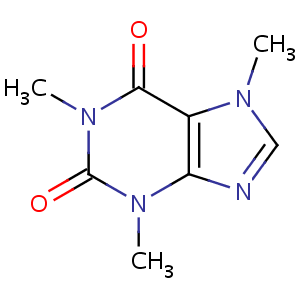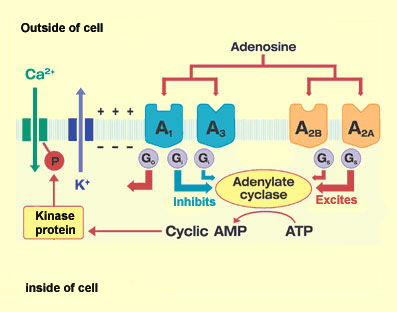Alice Piccato
CAFFEINE AND SERUM GLUCOSE
Caffeine is a xanthine alkaloid: it acts as a stimulating drug through several mechanisms of action.
Some of these mechanisms alter the level and the action of various important hormones that control the glucose homeostasis: in particular adrenaline, noradrenaline and insulin.
Caffeine item on 'flipper e nuvola' 

CAFFEINE AND ADENOSINE RECEPTOR
ADENOSINE RECEPTOR
The adenosine receptor (or P1 receptor) is a type of purinergic receptor.
Adenosine is the endogenous ligand.
In the human organism, there are four types of adenosine receptor, with a different distribution and action. All these receptor are coupled with a G protein. and in particular:
- A1: Gi/o, that reduces the concentration of cAMP;
- A2a: Gs, that increases the level of cAMP;
- A2b: Gs and Gq (that actives PLC, induces DAG and IP3 production and rises calcium concentration by IP3 dependent calcium channel on the ER – endoplasmic reticulum);
- A3: Gi/o.
Relative genes are called ADORA (respectively 1, 2A, 2B and 3).

A1 receptor has an inhibitory function. At presynaptic level, it reduces the synaptic vesicle release and suppresses the release of neurotransmitters like epinephrine, norepinephrine, acetylcholine and glutamate.
A1 and A2a receptors have a sedative effect in the brain.
Adenosine acts protecting the brain by:
- suppressing neural activity:
- increasing blood flow: conditions like lack of oxygen or interruption of blood flow, cause increasing of brain adenosine levels.
Adenosine is generated both by neurons (is a neurotransmitter) and metabolism of ATP (stress related-adenosine): in the second situation, adenosine play an important neuroprotective role.
Furthermore A1 receptor contributes to insulin-controlled glucose homeostasis and insulin sensitivity by:
- regulating insulin-mediated glucose uptake in muscle during contractions; Role of adenosine in regulating glucose uptake during contractions and hypoxia in rat skeletal muscle.1999
- regulating adipose tissue metabolism (adenosine inhibits lipolysis). Impaired glucose tolerance in the absence of adenosine A1 receptor signaling.2011
CAFFEINE EFFECT
Caffeine acts inhibiting adenosine receptors: it is a nonselectively antagonist and a competitive inhibitor. The effect of the caffeine is present also in the brain because the substance is both water-soluble and lipid-soluble, and it can cross the blood brain barrier.
The antagonist effect of the caffeine is responsible of:
- relative brain hypoperfusion; Caffeine and the central nervous system: mechanisms of action, biochemical, metabolic and psychostimulant effects.1992
- increasing epinephrine and norephinefrine release: in rats this effect is greater with a co-administration of insulin, and it is significantly reduced in adrenalectomized rats. Modulation of catecholamine release by endogenous adenosine in the rat adrenal medulla.2001
CAFFEINE AND PHOSPHODIESTERASE
Phosphodiesterase is an enzyme that degrades the beta-adrenergic messengers (cAMP, cyclic adenosine monophosphate).
Caffeine inhibits phosphodiesterase, and the consequent cAMP accumulation is one of the mechanisms responsible of the caffeine sympathomimetic effect.
Massive Catecholamine Release From Caffeine Poisoning.1982
CAFFEINE AND RYANODINE RECEPTOR
RYANODINE RECEPTOR
Ryanodine receptor (RyR) is a class of intracellular calcium channel.
It is a mediator of calcium induced calcium release, and it is localized in the vescicular membrane of endoplasmic reticulum.
Ryanodine and procaine are antagonists. Instead caffeine is an activator.
CAFFEINE EFFECT
Caffeine activates the RyR, and induces a dose-dependent calcium release.
Both ryanodine and procaine antagonize the caffeine effect. Effects of caffeine on intracellular calcium release and calcium influx in a clonal beta-cell line RINm5F.1996
Calcium release is important in adrenal medulla, for the esocytosis of secretory granules: it is strongly supported that fast calcium release may contribute to granules secretion. Calcium dynamics in bovine adrenal medulla chromaffin cell secretory granules.2008
CAFFEINE, ADRENALINE AND NORADRENALINE
ADRENERGIC RECEPTOR
The adrenergic receptor is a G protein coupled receptor.
It is the target of catecholamines, especially NE (norepinephrine or noradrenaline) and E (epinephrine or adrenalin).
There are two groups of adrenergic receptor:
- alfa receptors: alfa-1 is coupled with Gq, instead alfa-2 is associated with Gi;
- beta receptors: beta-1, beta-2 and beta-3 are all linked to Gs protein.

Beta-2 adrenergic receptor has an important role in the glucose homeostasis: it stimulates the glycogenolysis and the gluconeogenesis in liver.
Beta-3 adrenergic receptor promotes lipolysis in adipose tissue.
In fact hormone-sensitive lipase is activated by a cAMP-dependent protein kinase (PKA).
CAFFEINE EFFECT ON CATECHOLAMINE ACTION
Caffeine and other xanthine derivatives (for example theophylline) increase catecholamine secretion, that depends on dose of caffeine and concentration of calcium preloaded.
Also acetylcoline induce a catecholamine secretion, through muscarinic receptor that mobilezes calcium from an intracellular pool. It is important remember that the sympathetic nerves innervating adrenal medulla are cholinergic, and that caffeine increases the release of different neurotransmitters, like acetylcholine.
Additionally caffeine inhibit cyclic nucleotide phosphodiesterase, and cause an accumulation of adenosine cyclic monophosphate (cAMP), that is ad adrenergic receptor second messenger. The mode of action of caffeine on catecholamine release from perfused adrenal glands of cat.1989
In this way, caffeine can increase both the effect and the level of catecholamines.
CAFFEINE AND INSULIN RESISTANCE
INSULIN RECEPTOR
Insulin receptor (IR) is a transmembrane, tyrosine-kinase receptor.
It plays a key role in the glucose homeostasis. When IR is stimulated, it induces a phosphorylation of specific intracellular protein (IRS-1, Insulin Receptor Substrate 1), and this pathway leads to the transport of GLUT 4 (Glucose Transporter 4) from cellular vesicles to the cell surface. This mechanism is responsible of the insulin response in muscle and adipose tissue.

CAFFEINE EFFECT
Caffeine has a sympathomimetic effect.
The sympathetic nervous system induces insulin-resistance, and various different mechanisms have been described:
- inhibiting GLUT 4 transport to the cell surface;
- stimulating FFA production, that reduces the hepatic and peripheral glucose uptake (this effect is also caused by inhibiting adenosine-induced suppression of lypolisis Caffeine Can Decrease Insulin Sensitivity in Humans.2002);
- attenuating binding between insulin and its receptor;
- altering hexokinase activity.
A recent study demonstrated that insulin resistance is caused by beta-adrenoreceptor stimulation: epinephrine, norepinephrine and other agonists reduce insulin-induced glucose uptake from adipose tissue and skeletal muscle, by inhibiting GLUT 4 translocation to the plasma membrane.
Adrenergic receptor stimulation attenuates insulin-stimulated glucose uptake in 3T3-L1 adipocytes by inhibiting GLUT4 translocation.2005
Moreover caffeine can directly inhibit glucose uptake through antagonism of adenosine receptors.
A recent study shows that A2b receptor stimulation increses fasting blood glucose, by promoting IL-6 production and release. IL-6 is a proinflammatory mediator that contributes to insulin-resistance. The type 2 diabetes is associated with ADORA2B SNPs (that increses inflammation markers level). The antagonist caffeine effect on the adenosine-receptor reduces insulin resistance.
Links Between Insulin Resistance, Adenosine A2B Receptors, and Inflammatory Markers in Mice and Humans.2011.
In fact high and habitual caffeine consumption is associated with higher insulin sensivity.
But the results are different in short-term studies: caffeine acute intake reduces insulin sensivity and increases glucose concentration. Probably caffeine induces tolerance of the acute adverse effects in a long-term consumption.
Effects of Coffee Consumption on Fasting Blood Glucose and Insulin Concentrations.2004
Furthermore adenosine-receptor activation decreases insulin-sensivity in skeletal muscle, but seems to increase it in adipose tissue: then the final effect of adenosine receptor antagonism depends on the relative amount of muscle and fat tissue.
Caffeine Can Decrease Insulin Sensitivity in Humans.2002.
CONCLUSIONS
CAFFEINE AND SERUM GLUCOSE
Many studies show that caffeine in coffee raises blood sugar levels.
The higher glucose concentration, both daytime glucose and post-prandial glucose, is present in free-diabetic patients.
Caffeine Increases Ambulatory Glucose and Postprandial Responses in Coffee Drinkers With Type 2 Diabetes.2007
In conclusion, this increase of sugar level is caused by:
- release of catecholamines, induced both by A1 receptor inhibition and RyR stimulation, with a consequent increase of NE and E blood levels;
- accumulation of cAMP (a catecholamine second messenger), that is due to phosphodiesterase inhibition and that leads to an higher catecholamine effect;
both these mechanisms are responsible of a sympathomimetic effect;
- antagonism of adenosine receptor, that inhibits glucose uptake and alters adipose tissue metabolism.
CAFFEINE AND TYPE 2 DIABETES
Some studies report that drinking coffee reduces the risk of type 2 diabetes.
But other studies demonstrate that in type 2 diabetic patients the daily caffeine intake has a similar hyperglycemic effect then in healthy patients. This elevated glucose could impair efforts aimed at glucose control and increase risk of diabetes complications.
Caffeine Increases Ambulatory Glucose and Postprandial Responses in Coffee Drinkers With Type 2 Diabetes.2007
Type 2 diabetes item on 'flipper e nuvola' 